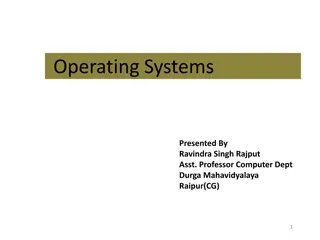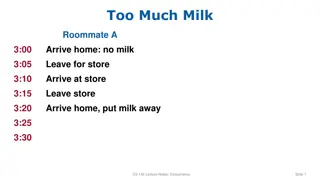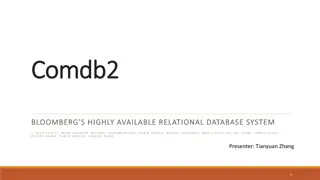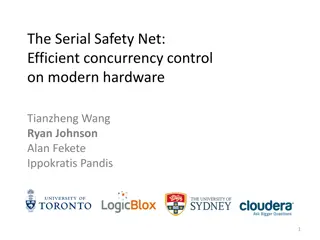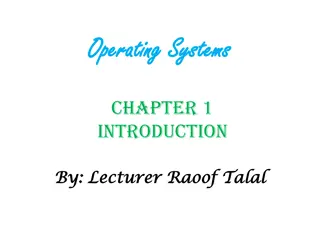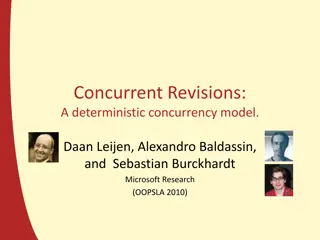Concurrency in Operating Systems
Concurrency is crucial for handling multiple tasks simultaneously in operating systems. Explore the motivations, benefits, and implementation of threads to enhance performance and user responsiveness. Delve into the definitions and examples of thread abstraction in the kernel and user-level, providing a comprehensive understanding of concurrency concepts.
Download Presentation

Please find below an Image/Link to download the presentation.
The content on the website is provided AS IS for your information and personal use only. It may not be sold, licensed, or shared on other websites without obtaining consent from the author.If you encounter any issues during the download, it is possible that the publisher has removed the file from their server.
You are allowed to download the files provided on this website for personal or commercial use, subject to the condition that they are used lawfully. All files are the property of their respective owners.
The content on the website is provided AS IS for your information and personal use only. It may not be sold, licensed, or shared on other websites without obtaining consent from the author.
E N D
Presentation Transcript
Motivation Operating systems (and application programs) often need to be able to handle multiple things happening at the same time Process execution, interrupts, background tasks, system maintenance Humans are not very good at keeping track of multiple things happening simultaneously Threads are an abstraction to help bridge this gap
Why Concurrency? Servers Multiple connections handled simultaneously Parallel programs To achieve better performance Programs with user interfaces To achieve user responsiveness while doing computation Network and disk bound programs To hide network/disk latency
Dj vu? Didn t we learn all about concurrency in CSE 332/333? More practice Realistic examples, especially in the project Design patterns and pitfalls Methodology for writing correct concurrent code Implementation How do threads work at the machine level? CPU scheduling If multiple threads to run, which do we do first?
Definitions A thread is a single execution sequence that represents a separately schedulable task Single execution sequence: familiar programming model Separately schedulable: OS can run or suspend a thread at any time Protection is an orthogonal concept Can have one or many threads per protection domain
Threads in the Kernel and at User-Level Multi-threaded kernel multiple threads, sharing kernel data structures, capable of using privileged instructions OS/161 assignment 1 Multiprocess kernel Multiple single-threaded processes System calls access shared kernel data structures OS/161 assignment 2 Multiple multi-threaded user processes Each with multiple threads, sharing same data structures, isolated from other user processes
Thread Abstraction Infinite number of processors Threads execute with variable speed Programs must be designed to work with any schedule
Thread Operations thread_create(thread, func, args) Create a new thread to run func(args) OS/161: thread_fork thread_yield() Relinquish processor voluntarily OS/161: thread_yield thread_join(thread) In parent, wait for forked thread to exit, then return OS/161: assignment 1 thread_exit Quit thread and clean up, wake up joiner if any OS/161: thread_exit
Example: threadHello #define NTHREADS 10 thread_t threads[NTHREADS]; main() { for (i = 0; i < NTHREADS; i++) thread_create(&threads[i], &go, i); for (i = 0; i < NTHREADS; i++) { exitValue = thread_join(threads[i]); printf("Thread %d returned with %ld\n", i, exitValue); } printf("Main thread done.\n"); } void go (int n) { printf("Hello from thread %d\n", n); thread_exit(100 + n); // REACHED? }
threadHello: Example Output Why must thread returned print in order? What is maximum # of threads running when thread 5 prints hello? Minimum?
Fork/Join Concurrency Threads can create children, and wait for their completion Data only shared before fork/after join Examples: Web server: fork a new thread for every new connection As long as the threads are completely independent Merge sort Parallel memory copy
bzero with fork/join concurrency void blockzero (unsigned char *p, int length) { int i, j; thread_t threads[NTHREADS]; struct bzeroparams params[NTHREADS]; // For simplicity, assumes length is divisible by NTHREADS. for (i = 0, j = 0; i < NTHREADS; i++, j += length/NTHREADS) { params[i].buffer = p + i * length/NTHREADS; params[i].length = length/NTHREADS; thread_create_p(&(threads[i]), &go, ¶ms[i]); } for (i = 0; i < NTHREADS; i++) { thread_join(threads[i]); } }
Implementing Threads: Roadmap Kernel threads Thread abstraction only available to kernel To the kernel, a kernel thread and a single threaded user process look quite similar Multithreaded processes using kernel threads (Linux, MacOS) Kernel thread operations available via syscall User-level threads Thread operations without system calls
Implementing threads Thread_fork(func, args) Allocate thread control block Allocate stack Build stack frame for base of stack (stub) Put func, args on stack Put thread on ready list Will run sometime later (maybe right away!) stub(func, args): OS/161 mips_threadstart Call (*func)(args) If return, call thread_exit()
Thread Stack What if a thread puts too many procedures on its stack? What happens in Java? What happens in the Linux kernel? What happens in OS/161? What should happen?
Thread Context Switch Voluntary Thread_yield Thread_join (if child is not done yet) Involuntary Interrupt or exception Some other thread is higher priority
Voluntary thread context switch Save registers on old stack Switch to new stack, new thread Restore registers from new stack Return Exactly the same with kernel threads or user threads OS/161: thread switch is always between kernel threads, not between user process and kernel thread
OS/161 switchframe_switch /* a0: old thread stack pointer * a1: new thread stack pointer */ /* Get new stack pointer from new thread */ lw sp, 0(a1) nop /* delay slot for load */ /* Allocate stack space for 10 registers. */ addi sp, sp, -40 /* Now, restore the registers */ lw s0, 0(sp) lw s1, 4(sp) lw s2, 8(sp) lw s3, 12(sp) lw s4, 16(sp) lw s5, 20(sp) lw s6, 24(sp) lw s8, 28(sp) lw gp, 32(sp) lw ra, 36(sp) nop /* delay slot for load */ /* Save the registers */ sw ra, 36(sp) sw gp, 32(sp) sw s8, 28(sp) sw s6, 24(sp) sw s5, 20(sp) sw s4, 16(sp) sw s3, 12(sp) sw s2, 8(sp) sw s1, 4(sp) sw s0, 0(sp) /* and return. */ j ra addi sp, sp, 40 /* in delay slot */ /* Store old stack pointer in old thread */ sw sp, 0(a0)
x86 switch_threads # Save caller s register state # NOTE: %eax, etc. are ephemeral pushl %ebx pushl %ebp pushl %esi pushl %edi # Change stack pointer to new thread's stack # this also changes currentThread movl SWITCH_NEXT(%esp), %ecx movl (%ecx,%edx,1), %esp # Restore caller's register state. popl %edi popl %esi popl %ebp popl %ebx ret # Get offsetof (struct thread, stack) mov thread_stack_ofs, %edx # Save current stack pointer to old thread's stack, if any. movl SWITCH_CUR(%esp), %eax movl %esp, (%eax,%edx,1)
A Subtlety Thread_create puts new thread on ready list When it first runs, some thread calls switchframe Saves old thread state to stack Restores new thread state from stack Set up new thread s stack as if it had saved its state in switchframe returns to stub at base of stack to run func
Involuntary Thread/Process Switch Timer or I/O interrupt Tells OS some other thread should run Simple version (OS/161) End of interrupt handler calls switch() When resumed, return from handler resumes kernel thread or user process Thus, processor context is saved/restored twice (once by interrupt handler, once by thread switch)
Faster Thread/Process Switch What happens on a timer (or other) interrupt? Interrupt handler saves state of interrupted thread Decides to run a new thread Throw away current state of interrupt handler! Instead, set saved stack pointer to trapframe Restore state of new thread On resume, pops trapframe to restore interrupted thread
Multithreaded User Processes (Take 1) User thread = kernel thread (Linux, MacOS) System calls for thread fork, join, exit (and lock, unlock, ) Kernel does context switch Simple, but a lot of transitions between user and kernel mode
Multithreaded User Processes (Take 1)
Multithreaded User Processes (Take 2) Green threads (early Java) User-level library, within a single-threaded process Library does thread context switch Preemption via upcall/UNIX signal on timer interrupt Use multiple processes for parallelism Shared memory region mapped into each process
Multithreaded User Processes (Take 3) Scheduler activations (Windows 8) Kernel allocates processors to user-level library Thread library implements context switch Thread library decides what thread to run next Upcall whenever kernel needs a user-level scheduling decision Process assigned a new processor Processor removed from process System call blocks in kernel
Question Compare event-driven programming with multithreaded concurrency. Which is better in which circumstances, and why?


